Investigating Impacts of Risk Influence Factors on the Consequences of Marine Accidents in China by SE-CNN-GRU Algorithm
Abstract
1. Introduction
- (1)
- A database of 1106 marine accidents that occurred within Chinese waters during the 2013–2024 period is established, and RIF data features were extracted as a dataset for the purpose of training machine learning algorithms.
- (2)
- A comprehensive machine learning algorithm (SE-CNN-GRU algorithm) aimed at exploring the influence mechanism of RIFs on marine accidents and the consequences thereof within Chinese waters is proposed. The proposed comprehensive machine learning algorithm is superior to more common machine learning algorithms, such as SVM, RF, and XGBoost, as verified in this study. The competitiveness of this comprehensive machine learning method may lie in its excellent performance in extracting feature information and in convolutional classification, as well as the combination of genetic algorithm features.
- (3)
- Some insights based on the results of the proposed machine learning algorithm are proposed in this study, which can be used to promote the safety of the shipping industry in China; in addition, potential applications of the proposed machine learning algorithm are also discussed.
2. Literature Review
2.1. Studies on the RIFs Involved in Marine Accidents
2.2. Application of Machine Learning Algorithms in the Shipping Industry Field
3. Materials and Methodology
3.1. Database Establishment
3.1.1. Marine Accident Investigation Report Collection
3.1.2. Labels for Marine Accident Consequences
3.1.3. Feature Extraction and Description
3.2. Feature Selection and Analysis
- (1)
- Feature selection: Choose the feature to be interpreted.
- (2)
- Grid point generation: Create a series of points across the range of the selected feature’s values.
- (3)
- Prediction calculation: For each grid point, keep all other features constant (at their mean or actual values) and calculate the model’s predicted outcome.
- (4)
- Curve plotting: Plot the grid points against their corresponding predicted values to visualize the relationship between the feature and the prediction.
3.2.1. Intelligent Optimization Genetic Algorithm (IOGA)
3.2.2. Spearman’s Correlation Coefficient
3.2.3. Kendall’s Tau Coefficient
3.2.4. Pearson’s Correlation Coefficient
3.3. Principle of the Proposed Methodology
- (1)
- The “1D-CNN layer” (with a kernel size of 3) slides across this 14-feature sequence. Its primary purpose is not to model time-series data but to automatically extract complex, localized associative patterns between adjacent features (e.g., how the combination of ‘Longitude’, ‘Latitude’, and ‘Channel condition’ might form a specific risk pattern).
- (2)
- The feature maps generated by the CNN (32 channels) are then passed to the ‘SE Module’. This module performs feature re-calibration, adaptively learning to ‘excite’ (amplify) the importance of the most predictive patterns (channels) and ‘squeeze’ (suppress) the less useful ones for that specific accident.
- (3)
- This re-weighted sequence of features is then fed into the **GRU layer**. The GRU models the higher-order sequential dependencies between these extracted, weighted features.
- (4)
- Finally, the output of the GRU is passed through a dense layer for the final classification (accident severity or type).
3.3.1. The Operating Principle of a CNN
3.3.2. Principle of SE Module
3.3.3. Principle of GRU
- (1)
- Architectural regularization, including “Batch Normalization” and a “Dropout layer (0.5)”;
- (2)
- The use of the “Adam optimizer” with a tuned “learning rate (0.001)” and “batch size (64)”, trained for 3500 epochs;
- (3)
- Most critically, the adoption of a “10-fold Cross-Validation” protocol (would be described in Section 4.2), which provides a robust and unbiased estimate of the model’s generalization performance on the available data.
4. Results Analysis
4.1. Database Description
- (1)
- Marine accidents are geographically concentrated both during the day and at night; specifically, almost all marine accidents in China occur in the waters of Bohai Bay, the Yangtze estuary, the Zhoushan Islands, the Taiwan Strait, the Pearl River estuary, the Qiongzhou Strait, and the Yangtze River, all of which can be collectively and concisely dubbed “six zones and one river”.
- (2)
- More marine accidents occur at night than during the day, especially catastrophic and severe accidents, which are marked by red and yellow in Figure 8. In addition, catastrophic and severe accidents mainly take the form of ship collision and foundering, which can easily lead to a high number of deaths/missing persons.
- (3)
- Safety management in Yangtze estuary and the Pearl River estuary should be given considerably more attention due to the heavy losses of life that occur there, especially at night. The reason for this may partly lie in the heavy marine traffic that is present in these two areas.
- (1)
- The tonnage of ships involved in overall accidents is usually less than 10,000 tons, while the ships involved in collision accidents generally had a tonnage above this weight; collisions mainly occurred between large merchant vessels and fishing ships.
- (2)
- Differences in age for various types of accidents can be observed to some extent. For example, the median and upper limits of ship age for ‘foundering’ and fire/explosion accidents are relatively higher, indicating that older vessels may be more prone to such severe incidents.
- (3)
- When focusing on the tonnage distribution of ships involved in accidents, it is interesting to observe the ‘two lines’ in Figure 10b: one represents 500 total tons (represented by green bar), and the other represents 3000 total tons (represented by red bar). These development of these two lines is mainly due to maritime regulations in China: the total tonnages of 500 and 3000 are set as the threshold values for ships, with different maritime regulations being applicable.
4.2. Experimental Results Analysis
Feature Analysis
4.3. Prediction Performance and Comparative Analysis
5. Conclusions
- (1)
- Continuous optimization of the total shipping fleet structure. According to the feature analysis in this study, vessel tonnage was identified as an important feature in the marine accident severity analysis. Generally, the larger the tonnage of a ship, the lower the probability of marine accidents, especially severe and catastrophic accidents.
- (2)
- Establishment of a warning mechanism for marine accident prevention (particularly urgent). The core aim of this study is to support a marine accident warning system; the important data features identified in this study and the developed prediction algorithm (SE-CNN-GRU) could be embedded into this system in the future.
- (3)
- Continuous improvement of the quality of data associated with marine accidents. A high quality of data, such as the data associated with the RIFs studied in this paper, is crucial for the performance of machine learning algorithms. For this purpose, a marine accident investigation regulation body would be advised to revise and standardize the data format of RIFs involved in the marine accidents. In addition, a database of marine risk factors, including RIFs, should be established as soon as possible, as should regulations for data management and utilization, which would activate the significant potential of artificial intelligence use in the field of marine accident prevention.
- (4)
- Enrichment of the dataset for predicting the consequences of marine accidents. Most existing studies focus on RIFs in terms of predicting marine accidents; however, many organizational and human factors also play important roles in determining the severity and type of marine accidents. That being said, data on organizational and human factors is hard to obtain. It can be reasonably anticipated that the combination of RIFs and organizational and human factors would further improve the existing machine learning algorithms. Therefore, it is advised that data on the organizational and human factors involved in marine accidents should also be standardized and collected in a legal way.
Author Contributions
Funding
Data Availability Statement
Conflicts of Interest
Appendix A. Pseudo-Code for the SE-CNN-GRU Algorithm
| Algorithm A1: Data Processing and CNN-GRU-SE Model Pipeline |
|
References
- Qiao, W.; Yang, J.; Zhao, Y. On the determination of the maritime-specific EPC values in reducing human factors based on maritime foundering accidents in China. Ocean Eng. 2024, 307, 118192. [Google Scholar] [CrossRef]
- Xing, W.; Zhu, L. Assessing the impacts of Sanchi incident on Chinese law concerning ship-source oil pollution. Ocean Coast. Manag. 2022, 225, 106227. [Google Scholar] [CrossRef]
- Fu, S.; Cui, M.; Wu, N.; Zhang, M.; Lang, X.; Mao, W. Evolution trends and influencing factors analysis for the severity and pollution of maritime accidents in Arctic waters from multi-source data. Reliab. Eng. Syst. Saf. 2026, 266, 111644. [Google Scholar] [CrossRef]
- Guan, W.; Zhang, C.; Dong, C.; Xia, Y. Ship fire and explosion accident statistical analysis based on fault tree and Bayesian network. Fire Saf. J. 2025, 153, 104358. [Google Scholar] [CrossRef]
- Qiao, W.; Huang, E.; Zhang, M.; Ma, X.; Liu, D. Risk influencing factors on the consequence of waterborne transportation accidents in China (2013–2023) based on data-driven machine learning. Reliab. Eng. Syst. Saf. 2025, 257, 110829. [Google Scholar] [CrossRef]
- Rosness, R. Risk Influence analysis: A methodology for identification and assessment of risk reduction strategies. Reliab. Eng. Syst. Saf. 1998, 60, 153–164. [Google Scholar] [CrossRef]
- Deng, J.; Liu, S.; Shu, Y.; Hu, Y.; Xie, C.; Zeng, X. Risk evolution and prevention and control strategies of maritime accidents in China’s coastal areas based on complex network models. Ocean Coast. Manag. 2023, 237, 106527. [Google Scholar] [CrossRef]
- Yu, J.; Zhao, J.; Wang, X.; Cao, Y. Maritime occupational accidents analysis: A data-driven Bayesian network approach. Ocean Coast. Manag. 2025, 269, 107785. [Google Scholar] [CrossRef]
- Feng, Y.; Wang, X.; Chen, Q.; Yang, Z.; Wang, J.; Li, H.; Xia, G.; Liu, Z. Prediction of the severity of marine accidents using improved machine learning. Transp. Res. Part E Logist. Transp. Rev. 2024, 188, 103647. [Google Scholar] [CrossRef]
- Cao, W.; Wang, X.; Li, J. A novel integrated method for heterogeneity analysis of marine accidents involving different ship types. Ocean Eng. 2024, 312, 119295. [Google Scholar] [CrossRef]
- Xiao, Z.; Xie, M.; Wang, X. Risk assessment of emergency operations of floating storage and regasification unit. J. Mar. Eng. Technol. 2024, 23, 357–372. [Google Scholar] [CrossRef]
- Fu, S.; Wu, M.; Zhang, Y.; Zhang, M.; Han, B.; Wu, Z. Coupling and causation analysis of risk influencing factors for navigational accidents in ice-covered waters. Ocean Eng. 2025, 320, 120280. [Google Scholar] [CrossRef]
- Jiang, H.; Zhang, J.; Wan, C.; Zhang, M.; Soares, C.G. A data-driven Bayesian network model for risk influencing factors quantification based on global maritime accident database. Ocean Coast. Manag. 2024, 259, 107473. [Google Scholar] [CrossRef]
- Li, H.; Ren, X.; Yang, Z. Data-driven Bayesian network for risk analysis of global maritime accidents. Reliab. Eng. Syst. Saf. 2023, 230, 108938. [Google Scholar] [CrossRef]
- Cao, Y.; Iulia, M.; Majumdar, A.; Feng, Y.; Xin, X.; Wang, X.; Wang, H.; Yang, Z. Investigation of the risk influential factors of maritime accidents: A novel topology and robustness analytical framework. Reliab. Eng. Syst. Saf. 2025, 254, 110636. [Google Scholar] [CrossRef]
- Dugan, S.A.; Utne, I.B. Improved identification of maritime risk-influencing factors using AIS data in regression analysis. Reliab. Eng. Syst. Saf. 2025, 262, 111156. [Google Scholar] [CrossRef]
- Yin, J.; Khan, R.U.; Afzaal, M.; Almalki, H.M.; Khasawneh, M.A.S.; Al Sulaie, S. Quantitative risk assessment of speech acts and lexical factors in maritime communication failures and accidents. Saf. Sci. 2025, 191, 106968. [Google Scholar] [CrossRef]
- Cao, Y.; Wang, X.; Wang, Y.; Fan, S.; Wang, H.; Yang, Z.; Liu, Z.; Wang, J.; Shi, R. Analysis of factors affecting the severity of marine accidents using a data-driven Bayesian network. Ocean Eng. 2023, 269, 113563. [Google Scholar] [CrossRef]
- Wang, J.; Fan, H.; Chang, Z.; Lyu, J. Unleashing data power: Driving maritime risk analysis with Bayesian networks. Reliab. Eng. Syst. Saf. 2025, 264, 111310. [Google Scholar] [CrossRef]
- Kamal, B.; Çakır, E. Data-driven Bayes approach on marine accidents occurring in Istanbul strait. Appl. Ocean Res. 2022, 123, 103180. [Google Scholar] [CrossRef]
- Wang, X.; Cao, W.; Li, T.; Feng, Y.; Uğurlu, Ö.; Wang, J. An integrated multidimensional model for heterogeneity analysis of maritime accidents during different watchkeeping periods. Ocean Coast. Manag. 2025, 264, 107625. [Google Scholar] [CrossRef]
- Wang, H.; Liu, Z.; Wang, X.; Graham, T.; Wang, J. An analysis of factors affecting the severity of marine accidents. Reliab. Eng. Syst. Saf. 2021, 210, 107513. [Google Scholar] [CrossRef]
- Brandt, P.; Munim, Z.H.; Chaal, M.; Kang, H.-S. Maritime accident risk prediction integrating weather data using machine learning. Transp. Res. Part D Transp. Environ. 2024, 136, 104388. [Google Scholar] [CrossRef]
- Munim, Z.H.; Sørli, M.A.; Kim, H.; Alon, I. Predicting maritime accident risk using automated machine learning. Reliab. Eng. Syst. Saf. 2024, 248, 110148. [Google Scholar] [CrossRef]
- Wang, J.; Zhou, Y.; Zhuang, L.; Shi, L.; Zhang, S. A model of maritime accidents prediction based on multi-factor time series analysis. J. Mar. Eng. Technol. 2023, 22, 153–165. [Google Scholar] [CrossRef]
- Liu, X.; Ji, H.; Teixeira, Â.P.; Rong, H.; Yu, Q. Enhancing maritime accident causation analysis through a hybrid machine learning approach. Reliab. Eng. Syst. Saf. 2025, 267, 111821. [Google Scholar] [CrossRef]
- Douzas, G.; Bacao, F. Geometric SMOTE a geometrically enhanced drop-in replacement for SMOTE. Inf. Sci. 2019, 501, 118–135. [Google Scholar] [CrossRef]
- Rao, C.; Wei, X.; Xiao, X.; Shi, Y.; Goh, M. Oversampling method via adaptive double weights and Gaussian kernel function for the transformation of unbalanced data in risk assessment of cardiovascular disease. Inf. Sci. 2024, 665, 120410. [Google Scholar] [CrossRef]
- Monteiro, T.G.; Skourup, C.; Zhang, H. Optimizing CNN hyperparameters for mental fatigue assessment in demanding maritime operations. IEEE Access 2020, 8, 40402–40412. [Google Scholar] [CrossRef]
- Suo, Y.; Chen, W.; Claramunt, C.; Yang, S. A ship trajectory prediction framework based on a recurrent neural network. Sensors 2020, 20, 5133. [Google Scholar] [CrossRef] [PubMed]
- Liu, L.; Zhang, Y.; Hu, Y.; Wang, Y.; Sun, J.; Dong, X. A hybrid-clustering model of ship trajectories for maritime traffic patterns analysis in port area. J. Mar. Sci. Eng. 2022, 10, 342. [Google Scholar] [CrossRef]
- Wang, C.; Li, G.; Han, P.; Osen, O.; Zhang, H. Impacts of COVID-19 on ship behaviours in port area: An AIS data-based pattern recognition approach. IEEE Trans. Intell. Transp. Syst. 2022, 23, 25127–25138. [Google Scholar] [CrossRef]
- Kim, G.; Lim, S. Development of an interpretable maritime accident prediction system using machine learning techniques. IEEE Access 2022, 10, 41313–41329. [Google Scholar] [CrossRef]
- Lan, H.; Wang, S.; Zhang, W. Predicting types of human-related maritime accidents with explanations using selective ensemble learning and SHAP method. Heliyon 2024, 10, e30046. [Google Scholar] [CrossRef]
- Wu, Z.; Wang, S.; Li, L.; Suo, Y. An interpretable ship risk model based on machine learning and SHAP interpretation technique. Ocean Eng. 2025, 335, 121686. [Google Scholar] [CrossRef]
- Cao, W.; Wang, X.; Feng, Y.; Zhou, J.; Yang, Z. Improving maritime accident severity prediction accuracy: A holistic machine learning framework with data balancing and explainability techniques. Reliab. Eng. Syst. Saf. 2026, 266, 111648. [Google Scholar] [CrossRef]
- Zhang, C.; Zou, X.; Lin, C. Fusing XGBoost and SHAP models for maritime accident prediction and causality interpretability analysis. J. Mar. Sci. Eng. 2022, 10, 1154. [Google Scholar] [CrossRef]
- Lin, Y.; Li, X.; Yuen, K. Machine learning applications for risk assessment in maritime transport: Current status and future directions. Eng. Appl. Artif. Intell. 2025, 155, 110959. [Google Scholar] [CrossRef]
- Xin, X.; Liu, K.; Loughney, S.; Wang, J.; Yang, Z. Maritime traffic clustering to capture high-risk multi-ship encounters in complex waters. Reliab. Eng. Syst. Saf. 2023, 230, 108936. [Google Scholar] [CrossRef]
- Ni, S.; Wang, N.; Li, W.; Liu, Z.; Liu, S.; Fang, S.; Zhang, T. A deterministic collision avoidance decision-making system for multi-MASS encounter situation. Ocean Eng. 2022, 266, 113087. [Google Scholar] [CrossRef]
- Huang, C.; Wang, X.; Wang, H.; Kong, J.; Zhou, J. A novel regional ship collision risk assessment framework for multi-ship encounters in complex waters. Ocean Eng. 2024, 309, 118583. [Google Scholar] [CrossRef]
- Zhang, Y.; Sun, X.; Chen, J.; Cheng, C. Spatial patterns and characteristics of global maritime accidents. Reliab. Eng. Syst. Saf. 2021, 206, 107310. [Google Scholar] [CrossRef]
- Seo, D.; Oh, S.; Lee, D. Classification and identification of spectral pixels with low maritime occupancy using unsupervised machine learning. Remote Sens. 2022, 14, 1828. [Google Scholar] [CrossRef]
- Sui, X.; Hu, M.; Wang, H.; Zhao, L. Measurement of coastal marine disaster resilience and key factors with a random forest model: The perspective of China’s global maritime capital. Water 2022, 14, 3265. [Google Scholar] [CrossRef]
- Rawson, A.; Brito, M. Developing contextually aware ship domains using machine learning. J. Navig. 2021, 74, 515–532. [Google Scholar] [CrossRef]
- Park, J.; Jeong, J.; Park, Y. Ship trajectory prediction based on bi-LSTM using spectral-clustered AIS data. J. Mar. Sci. Eng. 2021, 9, 1037. [Google Scholar] [CrossRef]
- Vukša, S.; Vidan, P.; Bukljaš, M.; Pavić, S. Research on ship collision probability model based on Monte Carlo simulation and Bi-LSTM. J. Mar. Sci. Eng. 2022, 10, 1124. [Google Scholar] [CrossRef]
- Liu, R.W.; Yuan, W.; Chen, X.; Lu, Y. An enhanced CNN-enabled learning method for promoting ship detection in maritime surveillance system. Ocean Eng. 2021, 235, 109435. [Google Scholar] [CrossRef]
- Gao, K.; Gao, M.; Zhou, M.; Ma, Z. Artificial intelligence algorithms in unmanned surface vessel task assignment and path planning: A survey. Swarm Evol. Comput. 2024, 86, 101505. [Google Scholar] [CrossRef]
- Lan, Z.; Gang, L.; Zhang, M.; Xie, W.; Wang, S. A multi-stage collision avoidance model for autonomous ship based on fuzzy set theory with TL-DDQN algorithm. Ocean Eng. 2024, 311, 118912. [Google Scholar] [CrossRef]
- Wang, Y.; Xu, H.; Feng, H.; He, J.; Yang, H.; Li, F.; Yang, Z. Deep reinforcement learning based collision avoidance system for autonomous ships. Ocean Eng. 2024, 292, 116527. [Google Scholar] [CrossRef]
- Higaki, T.; Hashimoto, H. Human-like route planning for automatic collision avoidance using generative adversarial imitation learning. Appl. Ocean Res. 2023, 138, 103620. [Google Scholar] [CrossRef]
- Jovanovic, I.; Percic, M.; Vladimir, N. Assessment of human contribution to cargo ship accidents using Fault Tree Analysis and Bayesian Network Analysis. Ocean Eng. 2025, 323, 120628. [Google Scholar] [CrossRef]
- Friedman, J.H. Greedy function approximation: A gradient boosting machine. Inst. Math. Stat. 2001, 29, 1189–1232. [Google Scholar] [CrossRef]

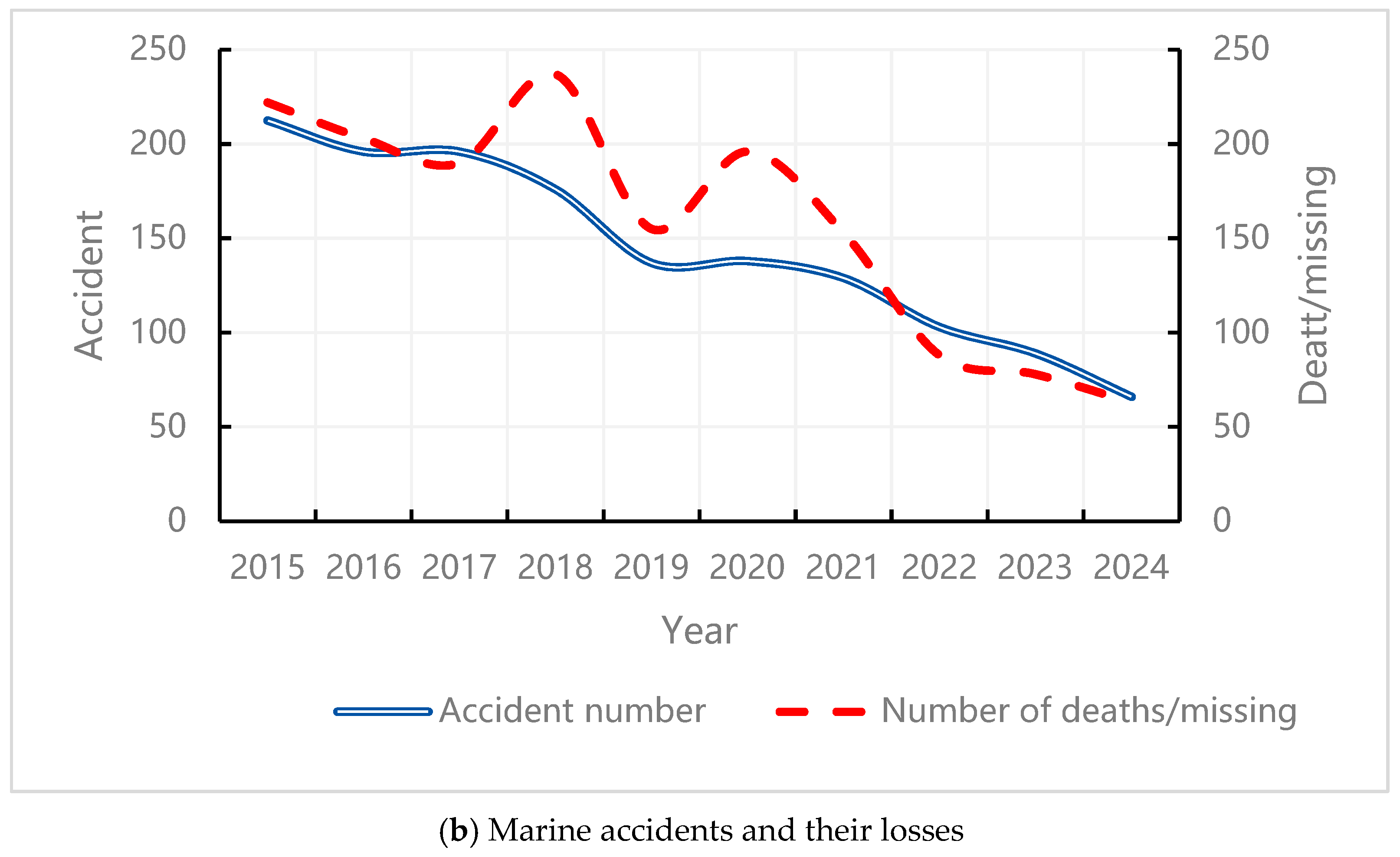
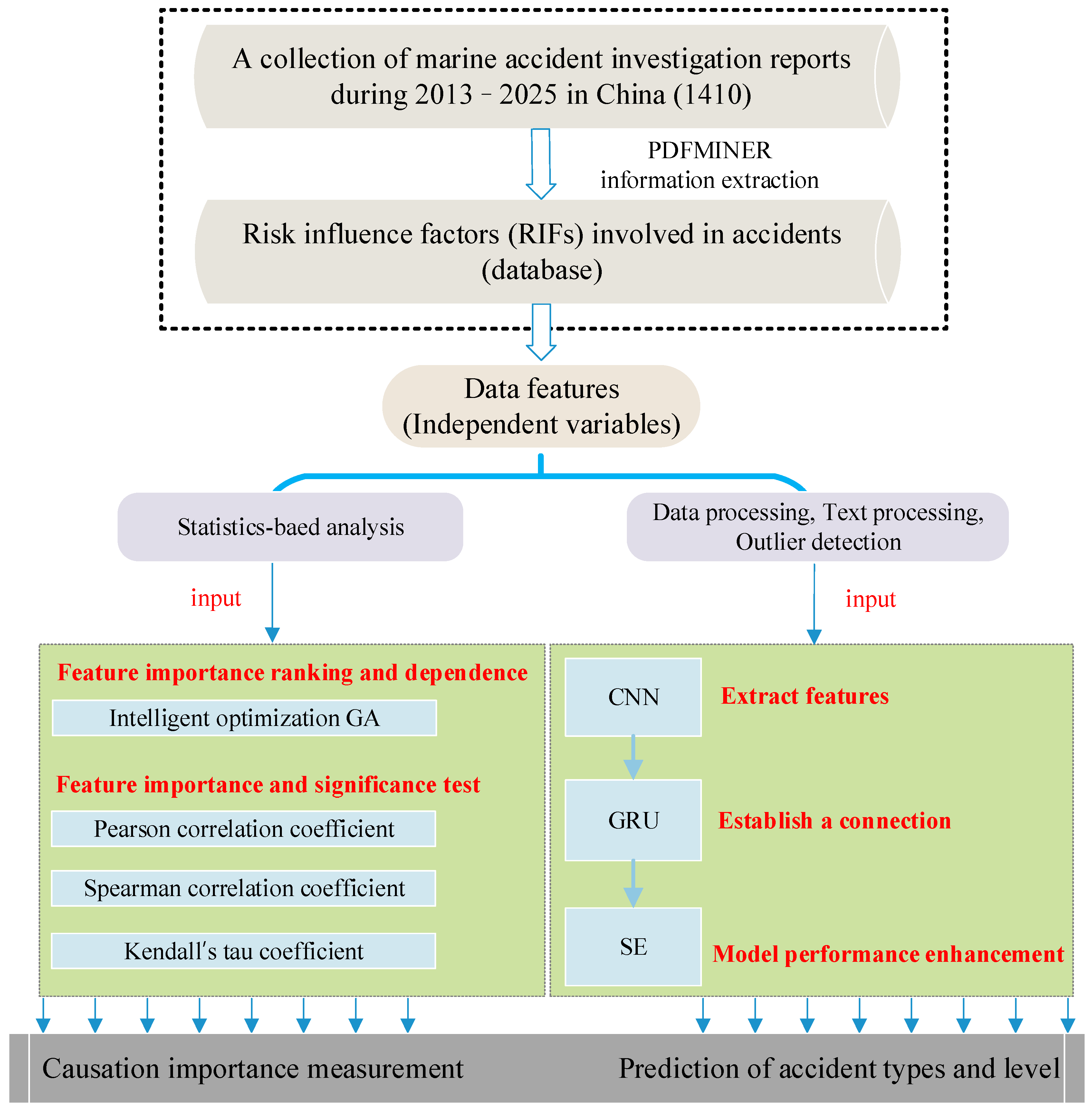







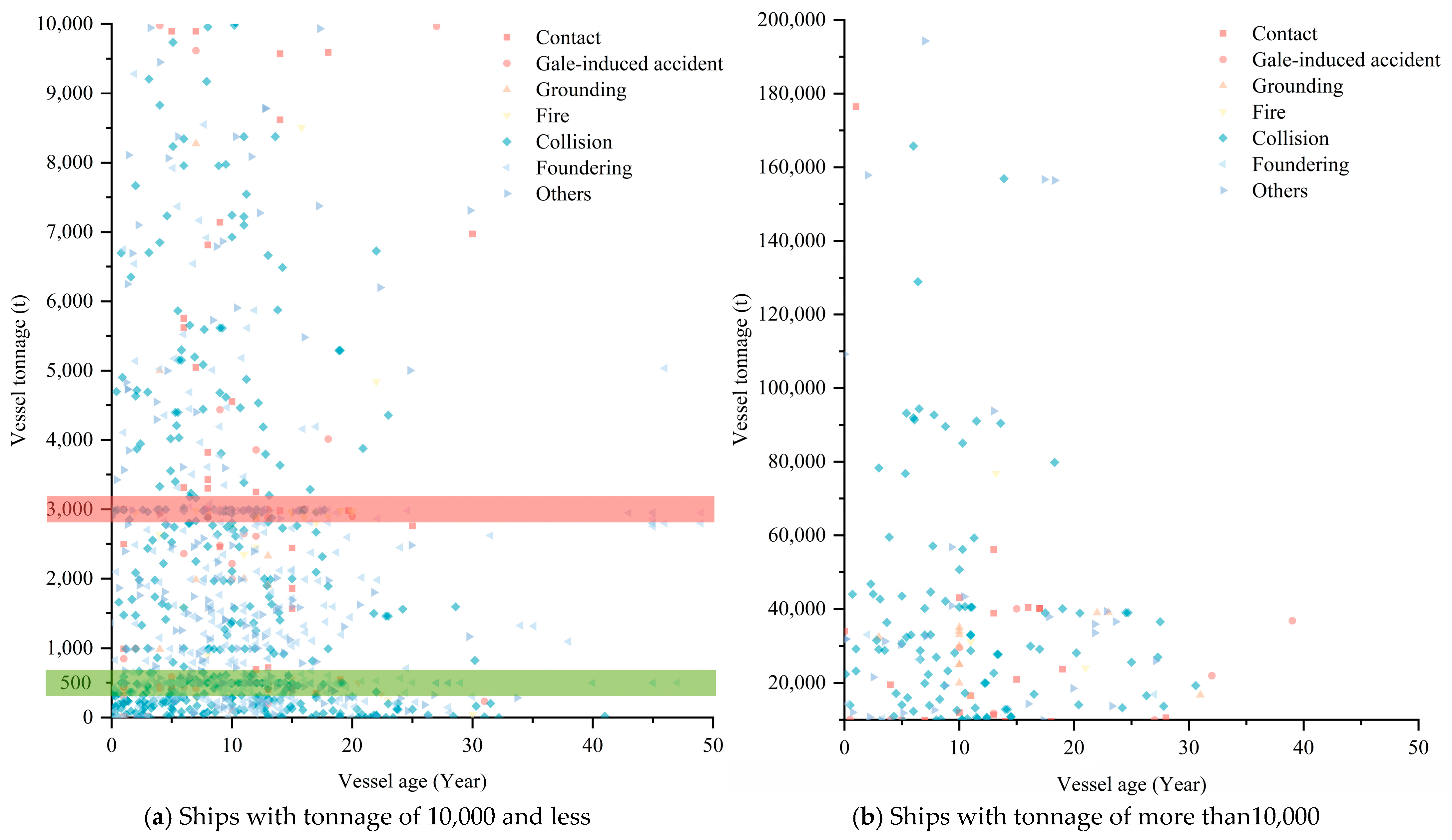
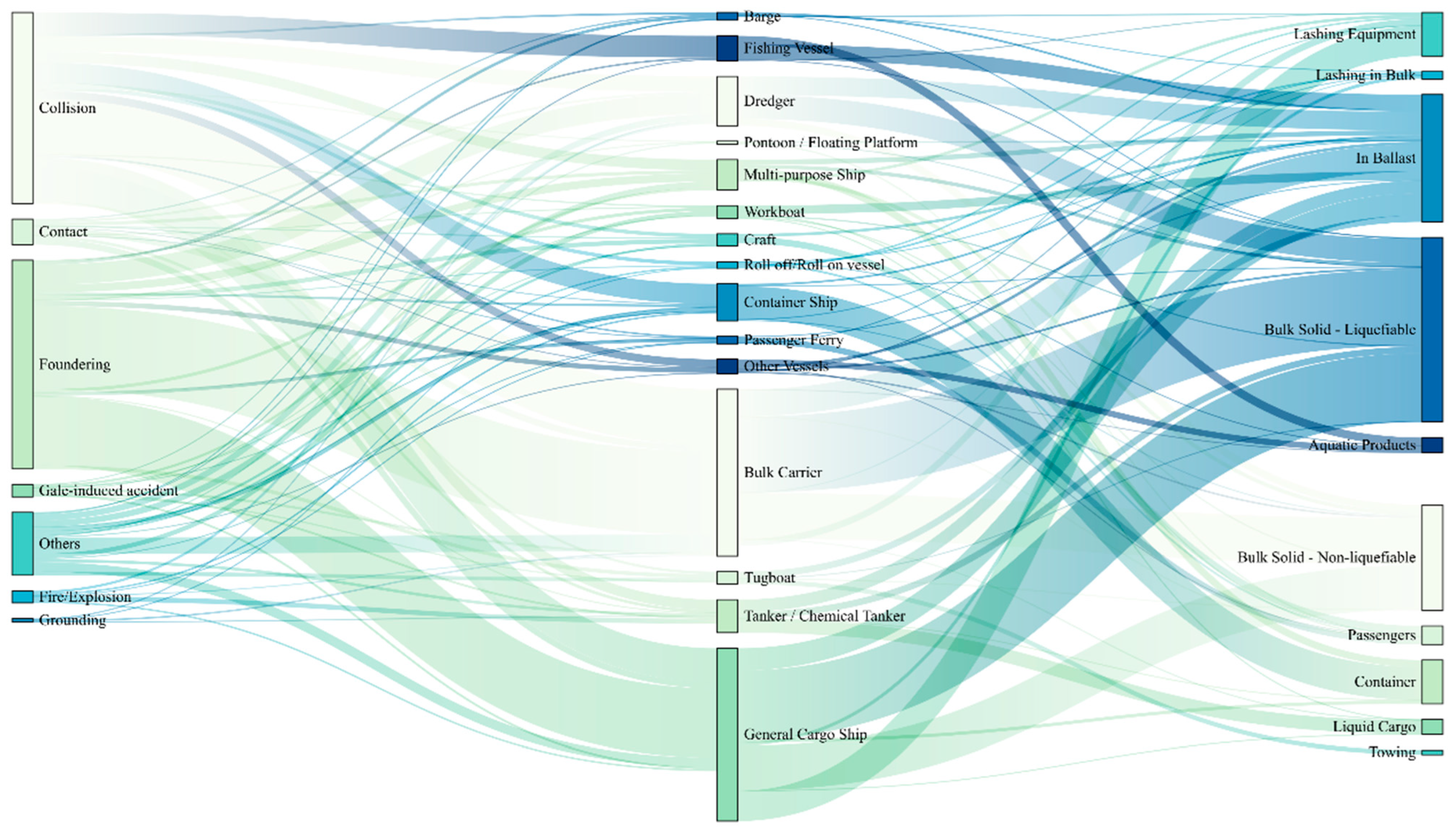






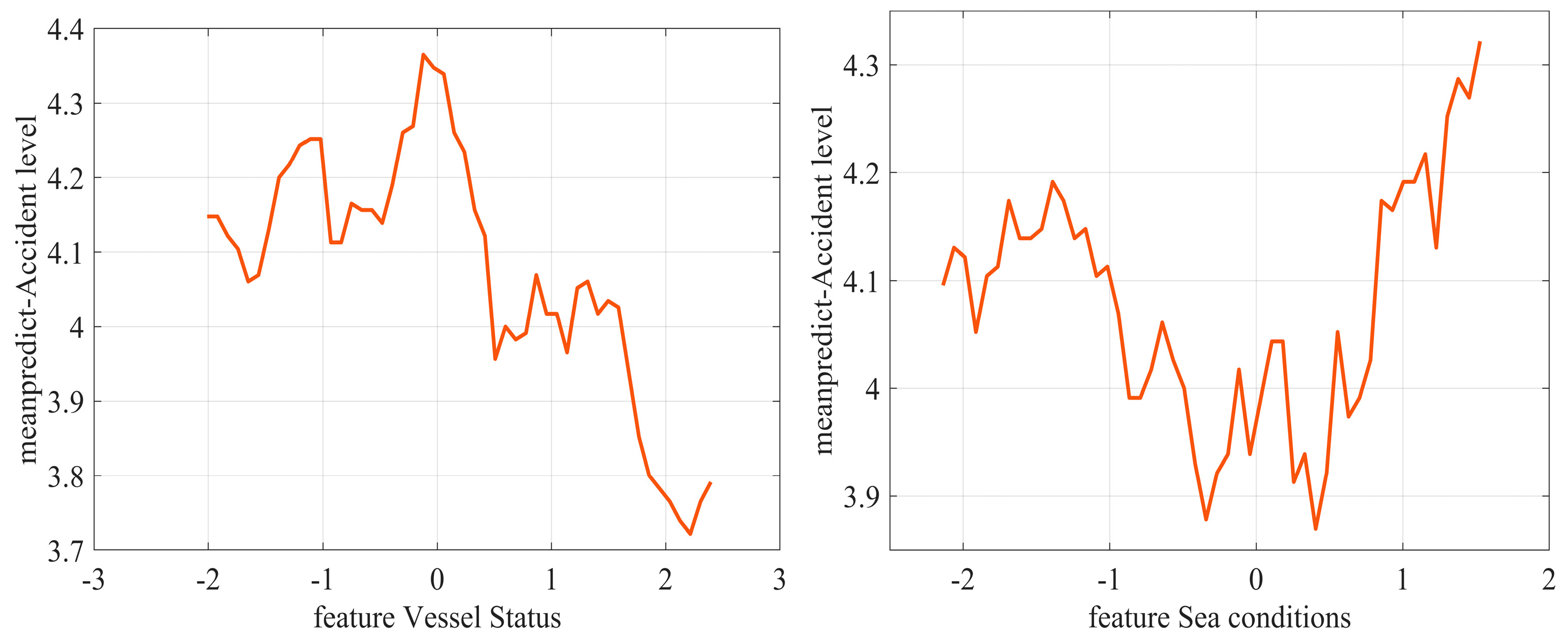


| Label | S1 (General Accident) | S2 (Heavy Accident) | S3 (Catastrophic) |
|---|---|---|---|
| contents | An accident that causes 1–3 deaths/missing, or 1–10 serious injuries, or direct economic losses of less than 10 million yuan | An accident that causes 3–10 deaths/missing, or 10–50 serious injuries, or direct economic losses of 10–50 million yuan | An accident that causes more than 10 deaths/missing, or more than 50 serious injuries, or direct economic losses of more than 50 million yuan |
| Feature | Code | Description |
|---|---|---|
| Coordinate | Long. Lati. | Longitude and latitude of the marine accident |
| Date | Dat. | The data when the marine accident occurred |
| Time | Tim. | The time in a day when the marine accident occurred |
| Channel condition | Cha. | Mainly referring to the natural condition of the navigation channel in terms of the degree of complexity, qualified into four levels (C1, C2, C3, C4), and C4 is the most complex |
| Traffic density | Di (i = 1,2,3) | The number of ships appeared in the waters where the marine accidents occurred, qualified into three levels (D1, D2, D3), and D1 indicates the maximum marine traffic density |
| Weather | Wi (i = 1,2,…,7) | Meteorological conditions when the marine accident occurred, including sunny(W1), cloudy(W2), fog(W3), thunder shower(W4), thunderstorm(W5), moderate rain(W6), heavy rain(W7) |
| Sea condition | Ri (i = 1,2,3) | Mainly referring to wind, wave, and current conditions, qualified into three levels (R1, R2, R3), and R1 represents rough sea |
| Vessel status | Ni (i = 1,2,3,4) | The navigational status of the ships when the marine accident occurred, including underway(N1), anchoring(N2), berthing(N3), cargo handling(N4), arrival/departure(N5), operation(N6) |
| Vessel category | Yi (i = 1,2,…,8) | The type of the accidental ships, including multi-purpose ship (Y1), general cargo ship(Y2), engineering ship(Y3), liquid cargo ship(Y4), barge(Y5), container(Y6), passenger ship (ro/ro ship) (Y7), tug(Y8) |
| Cargo category | Ci (i = 1,2,…,9) | Cargoes transported by the accident ships, including passenger(C1), lashed cargo in bulk(C2), bulk solid with no liquefying(C3), bulk solid with liquefying(C4), container(C5), lashed cargo as a whole(C6), no-load(C7), liquid cargo(C8), aquatic products(C9) |
| Navigation area | Hi (i = 1,2,3,4) | The waters where the marine accident occurred, including coastal waters(H1), inland waters(H2), ocean(H3), cover sea waters(H4) |
| Ship age | Age | The years from the new building to marine accident |
| Tonnage | Ton. | Total tonnage recorded on the ship’s certificate |
| Length | LOA | The length over all (LOA) of the accidental ship |
| Layer Type | Hyperparameters | Output Shape | Purpose |
|---|---|---|---|
| Input Layer | Number of Features: 14 | (Batch Size, 14, 1) | Receives raw maritime accident data. |
| Zerocenter | Number of Features: 14 | (Batch Size, 14, 1) | Normalization processing of data |
| Convolutional (Conv.) | Filters: 32, Kernel Size: 3, Activation: ReLU | (Batch Size, 12, 32) | Extracts associative patterns between local features. |
| Batch Norm | Batch: 12 | (Batch Size, 12, 32) | Controls overfitting, aids convergence |
| Pooling | Pool Size: 2 | (Batch Size, 6, 32) | Performs down-sampling to create robust features invariant to small shifts. |
| SE Module | Reduction Ratio: 4 | (Batch Size, 6, 32) | Adaptively recalibrates channel-wise feature responses. |
| GRU Layer | Units: 64 | (Batch Size, 64) | Model dependencies within the feature sequence. |
| Fully Connected (Dense) | Units: 32, Activation: ReLU | (Batch Size, 32) | Combines high-level features for classification. |
| Dropout Layer | Dropout Rate: 0.5 | (Batch Size, 32) | Regularization to prevent overfitting. |
| Output Layer (Dense) | Units: N_Classes, Activation: Softmax | (Batch Size, N_Classes) | Produces the final probability distribution over accident level and type. |
| Item | Specifications |
|---|---|
| CPU | 12th Gen Intel(R) Core(TM) i5-12490F 3.00 GHz (Intel Corporation, Santa Clara, CA, USA) |
| GPU | NVIDIA GeForce GTX 1660 (6 GB) (Nvidia Corporation, Santa Clara, CA, USA) |
| RAM | 32 GB |
| Language | Python 3.9.21, Matlab R2024a |
| Operating system | Windows 10 × 64 bit |
| ML Framework | Tensorflow 2.18.0, pytorch-lightning 2.4.0, keras 3.6.0 |
| Model | Accuracy | Precision | Recall | F1 Score | Specificity | 10-Fold CV Accuracy (Mean) | 10-Fold CV Accuracy (Std. Dev.) |
|---|---|---|---|---|---|---|---|
| SVM | 0.77391 | 0.56856 | 0.49045 | 0.51017 | 0.92883 | 0.72632 | 0.037266 |
| XGBoost | 0.66087 | 0.44657 | 0.34738 | 0.35501 | 0.91290 | 0.66626 | 0.050323 |
| GRU | 0.76957 | 0.51688 | 0.43569 | 0.45485 | 0.94808 | 0.76470 | 0.037300 |
| RF | 0.73043 | 0.35784 | 0.39292 | 0.37375 | 0.91818 | 0.70707 | 0.064002 |
| SE-CNN-GRU | 0.80217 | 0.55582 | 0.48620 | 0.48333 | 0.89089 | 0.82595 | 0.041821 |
| Model | Accuracy | Precision | Recall | F1 Score | Specificity | 10-Fold CV Accuracy (Mean) | 10-Fold CV Accuracy (Std. Dev.) |
|---|---|---|---|---|---|---|---|
| SVM | 0.90870 | 0.94618 | 0.79229 | 0.85314 | 0.88121 | 0.93466 | 0.034726 |
| XGBoost | 0.91739 | 0.95057 | 0.80647 | 0.86507 | 0.89333 | 0.94252 | 0.021772 |
| GRU | 0.89565 | 0.92469 | 0.78139 | 0.83886 | 0.87150 | 0.92943 | 0.018675 |
| RF | 0.92609 | 0.95489 | 0.82066 | 0.87653 | 0.90545 | 0.95119 | 0.016630 |
| SE-CNN-GRU | 0.93435 | 0.94869 | 0.83076 | 0.88064 | 0.92210 | 0.93858 | 0.032528 |
Disclaimer/Publisher’s Note: The statements, opinions and data contained in all publications are solely those of the individual author(s) and contributor(s) and not of MDPI and/or the editor(s). MDPI and/or the editor(s) disclaim responsibility for any injury to people or property resulting from any ideas, methods, instructions or products referred to in the content. |
© 2025 by the authors. Licensee MDPI, Basel, Switzerland. This article is an open access article distributed under the terms and conditions of the Creative Commons Attribution (CC BY) license (https://creativecommons.org/licenses/by/4.0/).
Share and Cite
Wang, X.; Huang, E.; Qiao, W. Investigating Impacts of Risk Influence Factors on the Consequences of Marine Accidents in China by SE-CNN-GRU Algorithm. J. Mar. Sci. Eng. 2025, 13, 2169. https://doi.org/10.3390/jmse13112169
Wang X, Huang E, Qiao W. Investigating Impacts of Risk Influence Factors on the Consequences of Marine Accidents in China by SE-CNN-GRU Algorithm. Journal of Marine Science and Engineering. 2025; 13(11):2169. https://doi.org/10.3390/jmse13112169
Chicago/Turabian StyleWang, Xiaofeng, Enze Huang, and Weiliang Qiao. 2025. "Investigating Impacts of Risk Influence Factors on the Consequences of Marine Accidents in China by SE-CNN-GRU Algorithm" Journal of Marine Science and Engineering 13, no. 11: 2169. https://doi.org/10.3390/jmse13112169
APA StyleWang, X., Huang, E., & Qiao, W. (2025). Investigating Impacts of Risk Influence Factors on the Consequences of Marine Accidents in China by SE-CNN-GRU Algorithm. Journal of Marine Science and Engineering, 13(11), 2169. https://doi.org/10.3390/jmse13112169










